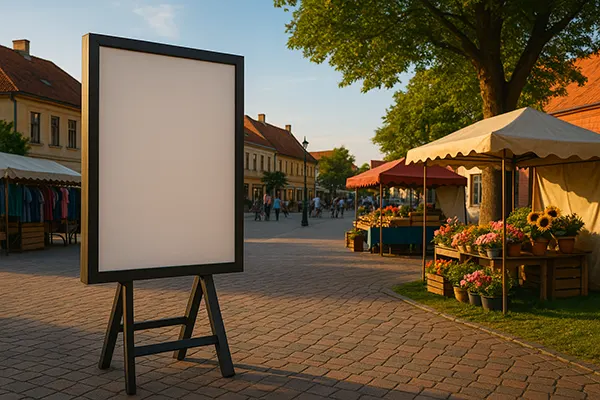
Street Advertising in Small Towns: Why It Works Better Than in Megacities
In an age where digital marketing dominates most business strategies, traditional forms of promotion still hold significant value, particularly in localised settings. One such method is street advertising, which, contrary to popular belief, proves exceptionally efficient in small towns. While metropolitan areas boast massive foot traffic and complex infrastructure, it is often the simplicity and intimacy of smaller communities that allow traditional advertising methods to thrive. This article explores why street advertising delivers stronger results in small towns compared to bustling megacities.
Stronger Community Engagement and Familiarity
Small towns offer an unparalleled sense of community, where people are more likely to notice and talk about visual messages in shared public spaces. Local residents often frequent the same streets and venues, creating repeated exposure to the same ads. This repetition helps with brand recall and creates a sense of familiarity that digital ads struggle to replicate.
Moreover, there is often a higher level of trust among small-town residents toward local businesses. An eye-catching poster or billboard displayed at the town square or on a familiar street corner can quickly generate word-of-mouth awareness. When businesses engage directly with their communities through street advertising, they tap into an existing social network built on trust and continuity.
In contrast, megacities are saturated with advertising across every channel. From LED screens to transit posters, the volume of marketing messages can overwhelm the average urban commuter. In this context, a single street ad is far more likely to be ignored than in a smaller town where competition for visual attention is considerably less fierce.
Word-of-Mouth Amplification in Smaller Communities
One of the defining characteristics of small towns is the rapid spread of information. A new sign outside a shop or a well-placed banner in the town square doesn’t just reach eyeballs — it sparks conversation. People talk to their neighbours, ask about new events or businesses, and generate organic buzz that extends the reach of street ads beyond their physical location.
This phenomenon is difficult to achieve in large urban centres, where anonymity prevails. A street ad in a city might reach thousands, but it’s far less likely to lead to meaningful conversation unless it’s part of a larger viral campaign. In smaller towns, a simple poster often achieves this naturally, thanks to the interconnectedness of the community.
Furthermore, local events such as markets or town fairs provide excellent opportunities for reinforced exposure. These gatherings typically occur in central areas where advertisements are prominently displayed and easily remembered, making them an ideal setting for street-level marketing.
Lower Costs with Higher Impact
Advertising in small towns tends to be significantly more cost-effective than in megacities. The expenses associated with renting billboard space, printing materials, or setting up installations are much lower in less densely populated areas. However, the lower price doesn’t mean reduced effectiveness — on the contrary, the return on investment can be far greater due to less clutter and stronger community ties.
In cities, high competition drives up advertising costs and reduces visibility. Ad spaces are often located in overcrowded districts where multiple messages compete simultaneously, which leads to visual noise. Small towns, on the other hand, have fewer advertisements, allowing a single poster to capture attention without distraction.
Local businesses especially benefit from these conditions. A modestly funded campaign can blanket the most frequented areas of a town, ensuring consistent visibility. This makes street advertising a viable choice not only for established local enterprises but also for startups and seasonal campaigns.
Affordability Empowers Local Creators
Because the cost barrier is lower in small towns, even businesses with limited budgets can create visually compelling campaigns. This affordability opens doors for collaboration with local artists, schools, or community groups to design more personalised, relatable messages that reflect the town’s identity.
Additionally, local governments and councils are often more flexible when it comes to regulations surrounding public advertising. Permits for placing signs or setting up stands are generally easier to obtain than in heavily regulated urban centres. This encourages greater creativity and frequency in campaign execution.
By keeping costs manageable and regulations supportive, small towns cultivate an advertising ecosystem that not only promotes local commerce but also enriches the visual and cultural landscape of the community.

Hyper-Targeted Reach and Message Retention
Street advertising in small towns benefits from a high degree of message precision. With a smaller, more homogenous population, advertisers can tailor their campaigns to align closely with the local culture, values, and purchasing habits. This specificity increases the chance of engagement and reduces the risk of miscommunication.
Additionally, people in small towns often move at a slower pace, which means they have more time to observe and absorb street ads. Whether walking to the shop, waiting at a bus stop, or attending local events, these slower rhythms provide ample opportunity for deeper message retention.
Unlike digital ads that can be skipped or blocked, a well-placed physical advertisement becomes a steady presence in daily routines. Over time, this leads to stronger associations between the brand and the environment in which it’s displayed, further boosting recall and consumer trust.
Customisation for Cultural Relevance
One of the most overlooked strengths of street advertising in small towns is the ability to create hyper-localised content. Whether referencing local landmarks, using dialects, or supporting town-specific causes, such campaigns resonate more deeply with the audience.
This type of cultural mirroring is much harder to achieve in a megacity, where diverse populations make it difficult to cater to everyone without diluting the message. In smaller towns, this focused customisation enhances the impact of each campaign, turning a simple banner into a meaningful community touchpoint.
Ultimately, the combination of message relevance, repetition, and emotional resonance ensures that street advertising remains not only relevant but highly effective in towns that value connection, tradition, and local pride.
